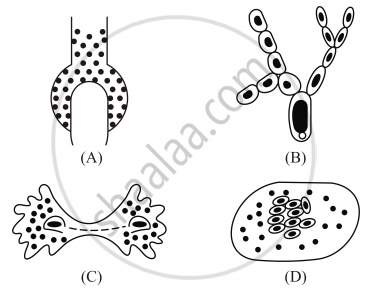Advertisements
Advertisements
Question
How does binary fission differ from multiple fission?
Solution 1
In binary fission, the parental cell divides into two daughter cells. In multiple fission, the parent organism keeps on dividing for innumerable times giving rise to many offsprings.
Solution 2
| Binary fission | Multiple fission |
| 1. The nucleus divides into two parts. | 1. The nucleus divides into many parts. |
| 2. It gives rise to new individuals. | 2. It gives rise to many individuals. |
| 3. Cytoplasm divides after each nuclear division. | 3. Cytoplasm does not divide after every nuclear division. |
| 4. eg. Amoeba. | 4. eg. Plasmodium. |
RELATED QUESTIONS
…………. is a mode of asexual reproduction.
(a) Cloning
(b) Budding
(c) Pollination
(d) Germination
List four modes of asexual reproduction.
On cutting the body of an organism into many pieces it was observed that many of these pieces developed as new individuals. Name the process and list two organisms in which this process may be observed. Draw a schematic diagram to illustrate the changes that are likely to be observed during the development of new individuals in any one of the organisms named.
What is metamorphosis?
Name the process by which an Amoeba reproduces. Draw the various stages of its reproduction in a proper sequence.
Explain vegetative propagation with the help of two examples. List two advantages of vegetative propagation.
What is meant by the term 'artificial propagation of plants'?
Name two plants which are usually propagated by artificial propagation methods. Name the method of artificial propagation used in each case.
Why does bread mould grow profusely on a moist slice of bread but not on a dry slice of bread?
Why do green grass plants spring up in dry fields on their own after the rains?
Define 'stock' and 'scion'.
State two advantages of grafting method of artificial propagation of plants.
The thread like structures that develop on a moist slice of bread in Rhizopus are ______.
Two very small organisms X and Y both reproduce by the method of budding. Organism X is industrially very important because it is used in making alcohol from sugar. It is also used in making bread. Organism Y Lives in freshwater. If organism Y gets cut into a number of parts accidently, each cut part can grow to form complete organism.
(a) What are organisms X and Y?
(b) What is the name of the process in which X converts sugar into alcohol?
(c) To which class of organisms does X belong?
(d) Name an important body feature of organism Y.
(e) Which organism is multicellular and which one is unicellular?
Write a short note on Vegetative reproduction.
Fill in the blank:
Yeast cells reproduce by ________.
Define the following:
Budding
Mention the common method of reproduction in Dahlia.
Mention the common method of reproduction in Mango.
Following diagrams were drawn by different student on having seen prepared slides of budding in yeast.
Correct diagrams are
(A) I, II, III
(B) II, III, IV
(C) III, IV, V
(D) I, IV, V
Binary fission is observed in which one of the following figures?

The plants produced as a result of vegetative reproduction are
Explain the importance of the reproduction process.
Seeds are the product of asexual reproduction.
During favourable conditions, Amoeba reproduces by ______
Which of the following statements are true for flowers?
- Flowers are always bisexual
- They are the sexual reproductive organs
- They are produced in all groups of plants
- After fertilisation they give rise to fruits
Which one of the following pairs is wrongly matched while the remaining three are correct?
Name the asexual reproductive structure of Chlamydomonas.
